Meal Prepping for Shift Work
TOPIC: Nutrition
Working a shift pattern can be difficult at the best of times. Unsociable hours, long working days and altered sleep patterns can wreak havoc with the physical training, social lives and health of those who labor under them.
This article looks at a few ways to plan ahead and structure your eating to help yourself in the gym, on the training field or even just in the times you’re at the coal face or avoiding it.

Written By
fred ormerod
Fred Ormerod is a freelance coach, army reserve medic, nurse, master’s student, and massage therapist. He’s spent a decade working in healthcare and five years coaching in one of Edinburgh’s leading training facilities.
Website
Programs
Set Yourself Up for Nutrition Success
Get Planned and Prepared
“Fail to prepare, prepare to feel peckish”
Planning and preparing meals ahead of time is a great way to make sure you’re fed throughout a shift, particularly if you work somewhere where you get regular breaks. Meal prepping is also associated with greater meal variety and lower risk of obesity in adults.
You can also save money buying foods in appropriate bulk or time throughout the week cooking and preparing meals. Studies show, unsurprisingly, that spending more time on preparing meals often leads to fewer take away meals and improved diet quality including more fruit and vegetables.
The beauty of prepared meals is that you can prepare both for days/nights when working and also when you’re not. This will help you stay on track and reach your goals all the sooner. This system can work particularly well on shift patterns where you might actually have time away from work to prepare the meals as well.
Make Food Enjoyable
Having meals prepared throughout a working day, provided it’s something you actually want to eat, can be something to look forward to if you’re having “one of those days.” Research tells us that meal preparation varies widely from region to region, culture to culture and person to person for all sorts of reasons: social influences, financial costs, tastes and time factors. All too often the social implications of preparing meals can get in the way of actually having a good meal.
We’ve all sat in a work canteen or similar and watched Judy from accounting nibble at crackers and lettuce leaves because she’s trying to “be good” only for her to have a hypoglycemic fit when the printer runs out of ink at 3pm. Then there’s Dan in marketing who claims to be dirty bulking or just getting some caffeine in with his two liter bottle of coke and subway foot-long. Both of these “hypothetical” characters have fallen victim to social influences on their meal planning.
Instead, having a meal that is prepared around a nutrition plan you or a coach has designed should leave you energetic throughout the day and not raging at inanimate objects or feeling bloated and stuffed.
How to Plan Your Meals Around Shift Work
First, it’s a good idea to know what your nutritional requirements actually are. Nutrition coaching can help with this but it’s actually not rocket science to work some of it out for yourself.
There are probably a hundred BMR calculators out there — BMR is simply (and I mean simply) the number of calories you burn throughout the day. If, for a period of time, you eat too many calories you will increase in body weight. Equally if you eat fewer, again over time or else there would be no such thing as a fitness industry, you will lose body weight (distinct from body fat).
Preparing meals that fit under or over this number as required is the starting block to know what to put into your meals.
Macro Considerations
If you’re not already working with macronutrient targets, it’s worth calculating how much protein, carbohydrate and fat you need to ingest (or at least getting some ballpark numbers to shoot for). Each macro is used by the body as a fuel source, but for different purposes. Each also has a different calorific content. This is the crux of “tracking your macros” see the table below.
| Macronutrient | Calories per gram of Macronutrient |
| Protein | 4 cals |
| Carbohydrate | 4 cals |
| Fat | 9 cals |
| Alcohol | 7 cals |
Again there are hundreds of food tracking apps available, industry standard is MyFitnessPal. Each tracker should tell you the macro content of your foods which you can work out before you make and eat the meals. This should give you the confidence that the meal you’re about to eat will leave you heading towards whatever nutritional goals you might have set yourself.
Finding Balance
Balancing your macros to suit your energy needs is really a case of experimentation and this is where meal variety can be fun! If you like to eat steamed chicken, broccoli and brown rice, then fill your boots. However, if that sounds boring (which it is) it’s definitely worth spending some time looking for different recipes that fit into your nutrient plan.
Weighing scales are important in this situation as well, so you can be sure that you’re getting enough or not too much of one thing. It’s very easy to fill a Tupperware with cooked rice and to think that one chicken breast or slice of salmon is enough when in fact you might be massively under/over feeding your protein, carb or fat demands (leading you to destroy yet another piece of company property as you circle the drain of either “hangriness” or digestive discomfort).
If you’re looking to get superhuman with your meal preparation, there are also micronutrients (vitamins and minerals) to be considered, but this is a minefield this article doesn’t have time to traverse. Suffice it to say that if you’re eating lots of varied fruits and veggies you’re probably doing a good job (6-10 portions/fistfuls per day is recommended).
Sport-Specific Nutrition
If you’re training for a sport, looking to lose weight or looking to improve your energy throughout the day then increasing protein intake to roughly 1.6-2g per kilo (1g/lb) of body weight is a prudent idea. This is dependent slightly on the sport/activity of choice.
If you’re of a cardiovascular persuasion (runners or cyclists for example) then considering 5-7g of carbohydrate per kilo of bodyweight is also a good idea. Fats can make up the rest of your calories and if it really has been “one of those f***ing days” you might even allow yourself an alcoholic beverage at the end of it (with obvious considerations for not drinking at work, or being hungover for work and for how unhelpful drowning ones’ sorrows in alcohol actually is both mentally and physically).
The potential drawback of this nutrition method is in the amount of kit and space it might require. Not everyone has a gigantic fridge or slow cooker to help in prepping and storing their smorgasbord. However, it isn’t all bad news. Meals can be prepped for as many days in advance as is required or you have space for and if you can freeze them you’ll find space for even more.
Here’s a kit list to help you out as well if you’re really stuck:
- Tupperware — this can be anything from luxury Pyrex to the cheapest recycled takeaway containers. They are good for controlling portion sizes, if it doesn’t fit it might be too much to eat in one sitting. They will help you save time and can be grabbed on the go and slung in a microwave as you need. They can usually be nicely stacked in the fridge
- Slow cooker/air fryer/rice cooker — Chuck in ingredients and let the rest happen; you can prep other things while this cooks
- Sandwich bags — make yourself a trail mix of treats you like choc chips, nuts, fruit etc for snacking on; can also be used to leak proof your older Tupperware
- Decent kitchen utensils — knives, spoons, slotted or otherwise, pans, travel spork; all of these have their place and it’s really handy to have ones that work. Learning how to use and look after them properly is a massive time saver as well. There’s an almost infinite source of tips on Youtube, though I would suggest that classic tools are often better than over engineered trinkets that “seem like a great idea”
- Simple spices — using spice rubs can transform what would otherwise have been a boring meal. Start off buying spices for new recipes and soon enough you’ll have an enviable collection to add flavor to all your meals. Pre-made rubs or flavorings are a quick and easy way to change things up also (the only difference between my “Chinese” chicken and my “Italian” chicken is whatever the packet says, the rest is all the same).
Food Glorious Food
At the end of the day, or at any time really if working in a shift pattern (after all it’s 5 o’clock somewhere), meal preparation should be about eating food you really like. If you don’t like to eat salad then don’t bother preparing salad, if you like burgers try making your own burgers so you know what’s in them. It’s a case of being sensible with portion control and nutrient balance. You’ll start to reap the rewards of your efforts sooner than you think.
Easy Meal Prep Recipes
Here are a couple of recipes to get you started on your meal prep mastery journey!
Middle Eastern-Style Chicken, Veggies And Rice
Time: 35 mins
Portions: 4
Calories: 296
Protein: 48.6g
Carbs: 2g
Fat: 11.8g
Fiber: 0.8g
Ingredients
- 2 packs microwave-ready whole grain brown rice
- 1 Tbsp vegetable oil
- 200g fresh green beans, trimmed and halved on the diagonal
- 1 large white onion, thinly sliced
- 1 large red bell pepper, thinly sliced
- Salt
- ¾ low-sodium chicken broth
- 250g shredded chicken breast meat
- ¾ tsp Ground cinnamon
- Small bunch fresh flat-leaf parsley leaves
- 3 Tbsp toasted pine nuts
How to Cook
- Prepare the rice according to package directions. Set aside.
- Heat the oil in a wok or large deep frying pan over high heat. Add the green beans and onions and cook, stirring frequently, until the onions are lightly browned, about 5 minutes.
- Add the peppers and 1/2 teaspoon salt and stir-fry until the green beans and peppers are crisp-tender, about 3 minutes. Add the broth, scraping up any browned bits. Stir in the shredded chicken, rice, cinnamon and 1/2 teaspoon salt and simmer until no excess liquid remains, about 1 minute. Season with salt.
- Transfer to a platter, sprinkle with the parsley and pine nuts and serve.
Squash Dhansak
Time: 30 mins
Portions: 4
Calories: 320
Protein: 9g
Carbs: 29g
Fat: 17g
Fibre: 7g
Ingredients
- 1 tbsp vegetable oil
- 500g butternut squash (1 small squash), peeled and chopped into bite-sized chunks (buy a pack of ready-prepared to save time)
- 100g chopped onions
- 4 heaped tbsp mild korma curry paste
- 400g can chopped tomatoes
- 400g can light coconut milk
- 400g can lentils drained
- 200g bag baby spinach
- 150ml coconut/natural yogurt
How to Cook
- Heat the oil in a large pan. Put the squash in a bowl with a splash of water. Cover with cling film and microwave on High for 10 mins or until tender.
- Meanwhile, add the onions to the hot oil and cook for a few mins until soft. Add the curry paste, tomatoes and coconut milk, and simmer for 10 mins until thickened to a rich sauce.
- Warm the naan breads in a low oven or in the toaster. Drain any liquid from the squash, then add to the sauce with the lentils, spinach and some seasoning. Simmer for a further 2-3 mins to wilt the spinach, then stir in the coconut yogurt. Serve with the warm naan and a dollop of extra yogurt.
- Try roasting the squash for an extra flavor.
Find Your Perfect Training Plan
Sometimes all you need to reach your destination on your fitness journey is an expert guide. Look no further, we've got you covered. Browse from thousands of programs for any goal and every type of athlete.
Try any programming subscription FREE for 7 days!
Related Articles
You May Also Like...
Building a Champion’s Gut: Why Athletes Need a High-Fiber Diet
Every inch of an athlete’s body is a finely tuned machine. From explosive power to unwavering endurance, peak performance relies on optimal fueling. Often overlooked, but essential for this internal engine, is a high-fiber diet. Here's why fiber is your secret weapon...
Functional Athletes Need Carbohydrates
The world of carbohydrates can be a difficult one to manage. They can leave you in a sweet spot of proper fuelling and recovery as an athlete, or crashing and burning when it matters most. This simple guide will hopefully give you a better idea of how best to...
Working Out During Ramadan: Maintaining & Making Gains
It’s falsely believed by many Muslim athletes that Ramadan = losing progress (gains!). This isn’t the case if you train, fuel, hydrate, and sleep appropriately. Of course that’s easier said than done, but following a few of these strategies can make all the difference...
Building a Champion’s Gut: Why Athletes Need a High-Fiber Diet
Every inch of an athlete’s body is a finely tuned machine. From explosive power to unwavering endurance, peak performance relies on optimal fueling. Often overlooked, but essential for this internal engine, is a high-fiber diet. Here's why fiber is your secret weapon...
Functional Athletes Need Carbohydrates
The world of carbohydrates can be a difficult one to manage. They can leave you in a sweet spot of proper fuelling and recovery as an athlete, or crashing and burning when it matters most. This simple guide will hopefully give you a better idea of how best to...


Want more training content?
Subscribe
For Coaches
For Athletes
About
Support
Training Lab
Access the latest articles, reviews, and case studies from the top strength and conditioning minds in the TH Training Lab!
Made with love, sweat, protein isolate and hard work in Denver, CO
© 2024 TrainHeroic, Inc. All rights reserved.





